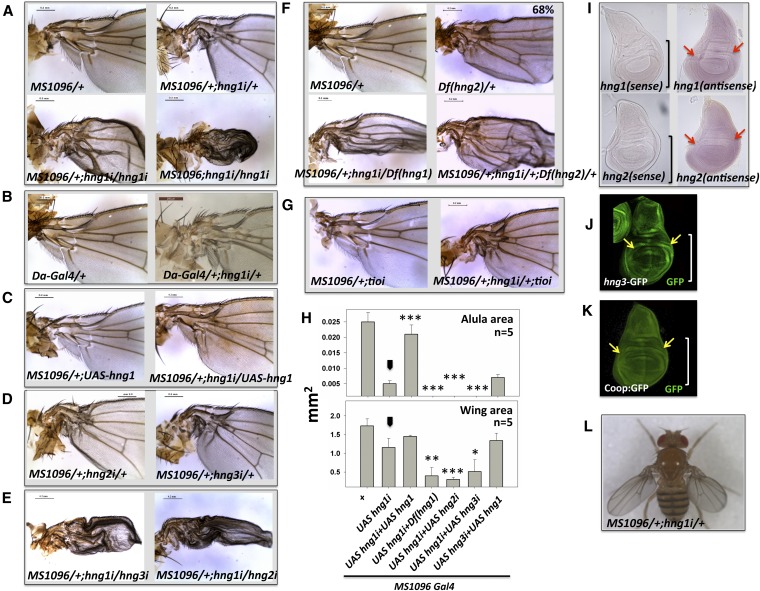Figure 3.
Members of the MADF-BESS family (CG9437/hng1, CG8359/hng2, and CG13897/hng3) have roles in the development of the wing hinge. (A) Reduction of CG9437 transcripts in the wing-imaginal disc, by expressing UAS-CG9437 RNAi line, in the MS1096 expression domain leads to wing-hinge defects in the adult fly. Defects include a reduced/mispatterned alula, a bent hinge, and a disorganized costa region. The phenotype is 100% penetrant and is dose dependent with an increased knockdown leading to a stronger phenotype that also affects the more distal wing blade. (B) Reduction of hng1 transcripts in the more ubiquitous daughterless (Da) expression domain also lead to wing-hinge defects, indicating specific roles for hng1 in the hinge. (C) The defects can be rescued by co-expression of UAS-hng1 in the same expression domain. Expression of UAS-hng1 by itself does not affect normal wing development. (D) Two other genes (CG8359/hng2 and CG13897/hng3) in the family also show a similar phenotype on knockdown. The genes have been named as the hinge genes based on their loss-of-function phenotype. (E) Double knockdowns of hng1+hng2 or hng1+hng3 in a single dose each mimic the phenotypes seen in an increase dose of hng1 knockdowns. (F) Deficiency in the 85B1-85C2 genomic regions removes hng2 completely, and 68% of flies show the wing-hinge phenotype. This, when combined with hng1 (MS1096/+; UAS-hng1-RNAi/+) knockdown, gives enhancement in the Deficiency phenotype. Deficiency in the 57C3-57C7 genomic region removes hng1 completely and also shows enhancement when combined with hng1 (MS1096/+; UAS-hng1-RNAi/+) knockdown. (G) The VDRC KK lines used in this study are inserted into a single site in the regulatory region of the tio locus. A knockdown of tio does not enhance the hng1i phenotype, arguing against a contribution of the tio locus to the observed phenotype. (H) Parameters such as wing size (mm2) and alula size (mm2) are measured to quantify the phenotype in this and subsequent experiments. The phenotype (MS1096/+; UAS-hng1 RNAi/+) is enhanced in the presence of a Deficiency in the CG9437/hng1 locus and is rescued by expressing UAS-hng1. Arrowhead indicates the MS1096/+; UAS-hng1/+ line used as a control for statistical analyses. *P < 0.05, **P < 0.01, and ***P < 0.001. (I) In situ hybridization against hng1 and hng2 transcripts confirms that hng1 and hng2 are expressed in wing imaginal discs. The brackets mark the wing pouch with the red arrows marking part of the hinge-forming region. (J) Expression pattern of hng3 as shown by anti-GFP staining of an enhancer trap line (YB0086DE) in wing imaginal discs. The bracket marks the wing pouch with the yellow arrows marking part of the hinge-forming region. (K) Expression pattern of Coop (CG1621) as shown by anti-GFP staining protein trap line in wing imaginal discs. The bracket marks the wing pouch with the yellow arrows marking part of the hinge-forming region. (L) The hng1i animal has a bent wing hinge, cannot fold its wings over the abdomen normally, and holds out its wings. The animals can flap their wings but cannot fly.

